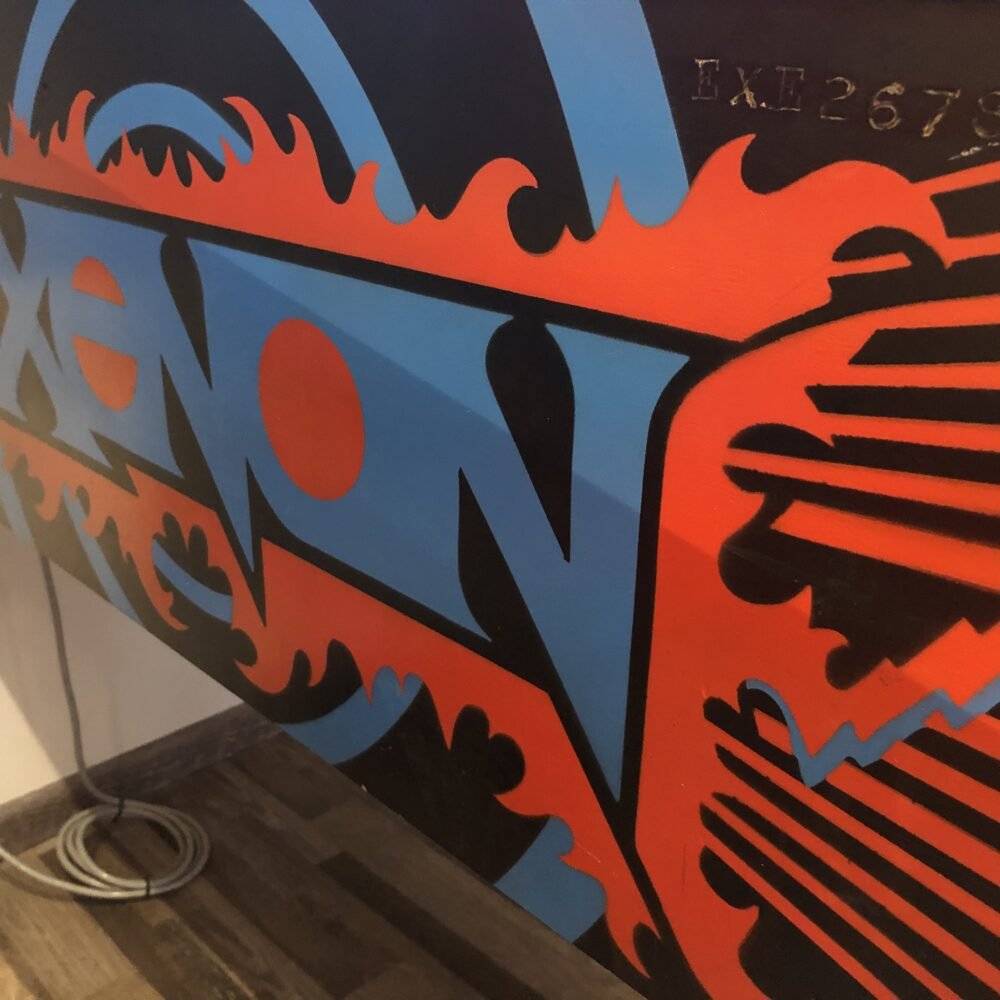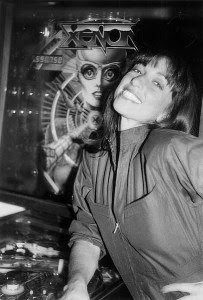Every pinball machine makes history. Manufacturer, theme, design, gameplay, so many reasons for so many models to leave a more or less indelible mark in the world of our dear pinballs.
But we have to admit that some machines have imposed themselves in the collective imagination as true classics of the good old days, which still speak to the enthusiasts that we are. And in the period of the 70s and 80s, some evocative names still resonate … Fathom, Black Hole, Centaur, Paragon, Black Knight, Xenon … Machines with bold themes and design close to real works of art. And it is on this last model, the famous Xenon game that we are going to focus today.
This machine, created by Bally in 1980, was the very first talking machine of the brand, but also and above all, the very first machine with a female voice. It is a visual nugget located halfway between Blade Runner, the cyberpunk trend and HR Giger’s works. If this particularity can be smiled at today, you can be sure that at the time, in the middle of these gambling games historically intended for a mainly male public (in fact), the novelty came to make a lot of noise in the middle of the other models and will have, for a large part, contributed to its success (11,000 copies produced all the same).
So, as Suzanne’s charming voice would say: “Welcome to Xenon”!
Sommaire
Xenon : a legendary artwork
It’s hard to talk about Xenon without talking about THE subject that still makes it a legendary machine: Its design. And more precisely the overall artwork of this machine. We don’t even know where to start, everything is so beautiful on this pinball machine.

Of course, the box blends in with the standards of the time and has a rather sober design since it is composed of the famous red lines symbolizing the light, which will be found everywhere on the rest of the artworks. But the lettering of the game’s title, faded in lightning reminding us of the futuristic technology, the black hole materialized by the blue circles symbolizing space and the faces surrounding the famous “X” on the sides of the pediment remind us that sobriety is not synonymous with poverty.
The backglass is a monumental slap in the face to half of the pinball machines that have been released up to that point, and is still far superior to most of the designs found on our recent machines.
Don’t get me wrong, we’re not just talking about the quality of Paul Faris’ design (Centaur, Paragon, Space Invaders or Phantom of the Opera, to name just a few of his finest masterpieces) but also about the technique used to achieve a totally unique and recognizable rendering when lit.
The backglass is actually composed of two panes. The first one, which has the painted shades and the second one, which has the majority of the design and the details that accompany it. Between these two panes: An air gap of about 5cm thick in which are fixed a whole row of bulbs that goes all around the frame. And to sublimate the whole: A set of 4 mirrors placed at the corners of the backglass, which reflect the light produced by the bulbs once lit. A real visual feat.




It’s obviously complicated to write it down, but I can guarantee you that the effect is really striking! When you know that the backglass of a machine (even more so at that time), forged in large part the identity of a pinball machine in the midst of all those that populated the game rooms, needless to say that Bally crushed the competition with its Xenon machine.
As for the board, it can be discovered like a painting as it seems to be trying to tell us a story. That of a science-fiction universe where you can access a gigantic futuristic lighthouse through a tube, which can be found both on the artwork and as a “ramp” in game. The rest of the elements oscillate between faces of men and women transforming into cybernetic creatures in the middle of robotic elements that look more or less like the interior of a spaceship.
What is Xenon? What story does this machine want to tell us? What is Faris trying to convey to us through these numerous details? It’s up to you to make your own idea of the theme because here, as on many machines at the time, there is no license but an original theme that you will have to interpret.






Xenon: Warrior Princess
If it is undeniable that this machine is a real visual prowess, on the gameplay side this is a different story! It’s not bad of course… but it’s unfortunately not very original. Of course we are in 1980 and the gameplay of the machines of this time does not equal yet the alphanumeric one of the end of the decade, nor the one of the DMD machines which will follow. But it is still quite surprising to find oneself in front of a machine so classic in its approach despite the numerous elements (some of which were innovative for the time) that compose its game board:
- A ramp (the famous tube)
- A ball lock
- A multiball of 2 balls
- Rollover switches (in the form of small push buttons) that activate the associated drop targets
Not to mention the classic elements: scoop, spinner, fixed & drop targets, slingshots and bumpers (4 of them) that complete the playfield.






The objective of this game (as well as many other models from this era) is to get back to the essence of pinball: scoring!
And to do this, you have to trigger the multipliers that will allow you to inflate the points, except that they are not always the easiest to understand. So you quickly find yourself playing only with the right part of the board, linking targets/ramp/targets/ramp, then sending the ball into the central scoop from time to time, and after 3 times, activating the ball lock and trying to start the famous multiball of 2, just to vary the gameplay a little.
Multiball, which seems to have been added at the last moment before the production to bring some extra content but which is only a not really attractive bonus : x10 on the spinner (!). I might as well tell you that it’s already not the funniest element of the game, nor the one that scores the most, but to make it the objective of the “final” game phase, it was clearly not the idea of the century…
So we find ourselves in multiball, sending our ball into the spinner, where we could have hoped for a slightly bigger bonus with other main elements of the playfield, in short… Go figure.
Xenon : sound and call-outs


As well as the visual aspect, the sound holds a very important place in this machine and the cybernetic creature with generous curves which is found on the stage (or through the face present on the backglass) also takes life thanks to its synthesized female voice.
And what a voice! Since it is the voice of Suzanne Ciani, electronic music composer who created the sound ambiance of this pinball machine but also lent her voice for the call-outs of this very first talking machine from Bally. And, as mentioned before, also the very first pinball machine with a female voice.
You can see a glimpse of her work in the video below. You can see the colossal task linked to the technical constraints of the time to integrate real voices in electronic objects.
For the rest, the background music is absolutely perfect. It has an increasing rhythm according to the actions to be performed, which artificially adds stress during the game phases (a bit like the heart sound effect that accelerates in Williams’ Gorgar) and forces you to concentrate to hope to get the multiball. Clean, neat and efficient!
Zarza significa Xenon do Brasil…
You may not know it, but in the 70s and 80s, the Brazilian market was also a consumer of pinball machines. Except that at the time, these machines were considered as gambling games (well, that’s a good thing!) and were therefore subject to high import taxes that were a deterrent for local operators.
But that’s no problem. If we can’t import pinball machines, let’s make them! And since the South American market can hardly be subject to the same legislation as in the North, let’s copy the great classics! We will save time and R&D…
That’s how many cult models have seen their Brazilian versions released under another name and with some visual differences (so as not to make a line for a line), notably by the brand Taito (nothing to do with the Japanese video game giant).
This joke obviously concerned the Xenon which, due to its success, was entitled to its Brazilian version: Zarza.
More than an inspiration, we have a pure and simple copy of the visual elements, rearranged in a different way, as shown by the backglass. The stage elements are, as for them, positioned in an identical way. The sound is completely reworked and not really for the best, we must admit…










We can hardly speak of a “Brazilian version” since the model is not exactly identical to the real one, but this anecdote reminds us that copying great successes, whatever they are, is not new…
Closer to us, I could also talk about Nuova Bell Games, the Italian company that made conversion kits for some Bally/Williams in order to make machines with a different name and look while keeping (more or less) the original mechanics since they notably roughly made up Xenon pinballs to make Cobra games (one of their 14 models released).
But this subject, as well as the Brazilian copies, deserves a separate article as there are so many things to say 🙂
Bite my shiny metal a** !
So in the end, what to think about this Xenon table? Well, this machine reminds us that a real success in the pinball industry is not only due to the quality of its game design but also to the quality of its artwork!
Because even if it is a truth that tends to disappear today, historically our favorite machines are money games dedicated to operators. To attract customers, you have to make them want to play and arouse their interest. This is obviously done through the quality of the game itself but also through its visual and sound attractiveness.
Bally, who combines both aspects by even going so far as to make his machine speak in attract mode with a woman’s voice, succeeded here in a real tour de force. The 11,000 copies sold prove it. Xenon is and will remain a cult machine of the 80’s on which, still today, we take a real pleasure to play, if only for the pleasure of the eyes…

